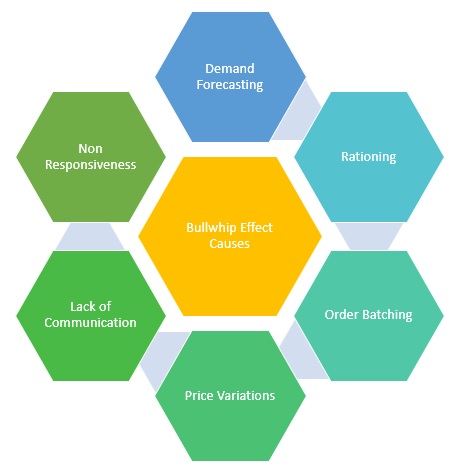- Business Concepts ›
- Operations and Supply Chain ›
- Bullwhip Effect
Bullwhip Effect - Definition, Factors & Example
This article covers meaning & overview of Bullwhip Effect from operations perspective.
Bullwhip Effect Definition
Bullwhip Effect is a phenomenon observed in forecast driven distribution channels where the amplification of the demand variance up the supply chain, from the customer to factory, as demand information passes back through the supply chain. It is also known as whiplash effect. In Simple words, Bullwhip effect is the small variation or fluctuation in customer demand resulting in fairly large variance for other stakeholders as we move up the supply chin i.e. distributors, wholesalers, retailers and manufacturer. As the name suggests, the result variance pattern is like a bullwhip or a whiplash.
Factors leading to Bullwhip Effect
There are various factors that lead to bullwhip effect:
1. Demand Forecasting Updating
Demand forecast updating refers to the situation where demand is non-stationary and one uses past demand information to update forecasts.
2. Rationing Gaming
The rationing gaming refers to the strategic ordering behavior of buyers when supply shortage is anticipated.
3. Order Batching
When fixed order cost is nonzero, ordering in every period would be uneconomical, and batching of orders would occur.
4. Price Variations
Price variations refer to non-constant purchase prices of the product.
5. Communication
lack of communication between various actors in the supply chain can lead to bullwhip effect.
6. Non Responsive Supply Chain

Issues associated with Bullwhip Effect
The issues associated with bull whip effect are:
1. Excess inventory,
2. Quality problems,
3. Increased raw material costs,
4. Increased shipping costs,
5. Lost Sales
6. Lost Customer Service.
Bullwhip Effect Example
Let us assume, a retailer sells crate of fruit juice cartons. On a normal day, he sells around 3 crates and stocked around 20 crates max in the shop. One day because of high temperature or a festival, few extra customers come to the retailer and buy 10 cartons for 2 days. The retailer assumes that the customer demand for that fruit juice has increased and he orders the wholesaler to send 50 cartons.
Now the demand was temporary but wholesaler also placed more order to distributor and distributor passed on same to manufacturer. The factory increased the production by 4 times so as to increase this demand. So a small increase in customer lead to 4 times more production at factory level. The fruit orchids and farmers also
This shows the bullwhip effect at work. Now imagine this for the whole city, each retailer might have assumed the same thing and wrongly forecasted the future demand. This example demonstrates the whiplash pattern from customer through distributor and wholesaler to the manufacturer and eventually to the fruit orchids. That is why the whiplash effect has to be totally avoided at all costs else it can lead to lot of issues in the entire supply chain.
Hence, this concludes the definition of Bullwhip Effect along with its overview.
This article has been researched & authored by the Business Concepts Team which comprises of MBA students, management professionals, and industry experts. It has been reviewed & published by the MBA Skool Team. The content on MBA Skool has been created for educational & academic purpose only.
Browse the definition and meaning of more similar terms. The Management Dictionary covers over 1800 business concepts from 5 categories.
Continue Reading:
What is MBA Skool?About Us
MBA Skool is a Knowledge Resource for Management Students, Aspirants & Professionals.
Business Courses
Quizzes & Skills
Quizzes test your expertise in business and Skill tests evaluate your management traits
Related Content
All Business Sections
Write for Us